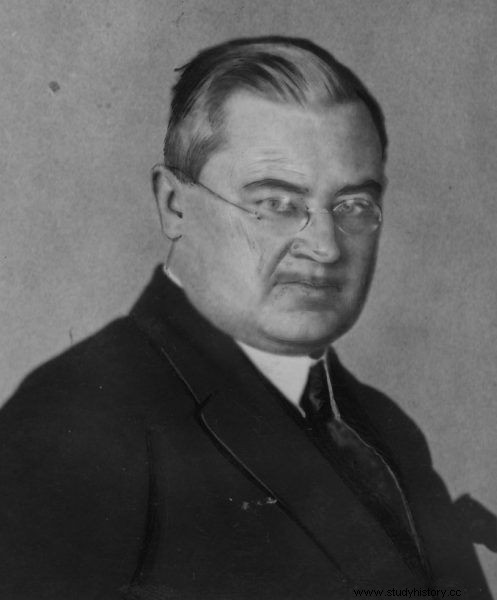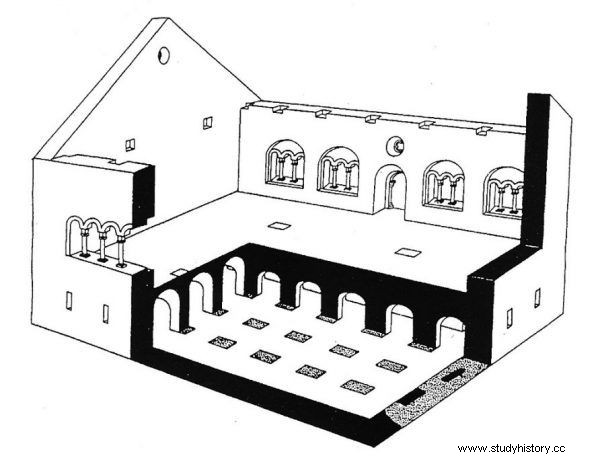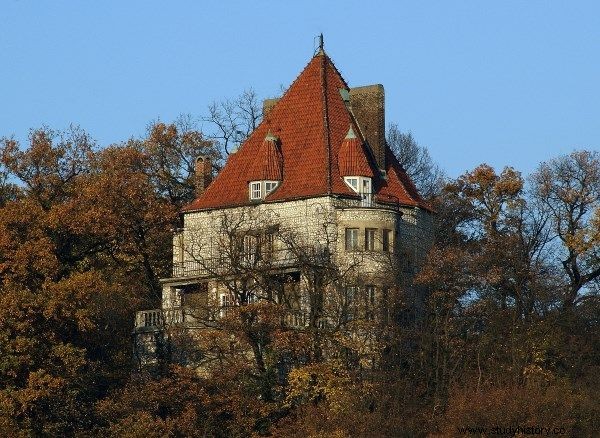For his contemporaries, he was a symbol of princely power, luxury and Latin culture. He inspired envy and respect. Until today, no visible trace of it has survived. This does not mean, however, that nothing can be said about the Krakow residence of the first Piasts.
Once, a thousand years ago, on a rocky hill by the Vistula River, the local rulers began to build their residence:a castle and a cathedral - wrote the Krakow journalist Jan Adamczewski. Far beyond the marshes and swamps lay the city called Krakow, which later grew and merged with Wawel - he added, and with this… he finished the topic. Karol Estreicher, the long-time director of the Jagiellonian University Museum and the author of countless publications on the history of Krakow, was equally laconic. During the 11th century, the prince's castle was also expanded - he quit as if in passing and went on to the next topics .
Numerous authors avoided details, because the beginnings of royal construction on the most important Polish hill are literally drowning in the darkness of history. There is a lack of information in period texts, and archeology faces serious difficulties. The relics of old buildings were devastated by builders from the following centuries. Their interpretation requires great scrupulousness, and often it is simply not possible. The situation is not improved by the fact that Wawel was built up in layers. In the place of the oldest structures there are those from the following centuries. And only the demolition of the Royal Castle would allow us to see exactly what's underneath.

Adolf Szyszko-Bohusz. It all started with him.
Twelve poles too far
It is generally known that before the construction of the first ducal palace on the Wawel Hill, there were already some buildings. Certainly, at the turn of the 9th and 10th centuries, the oldest wooden and earth embankment was built, surrounding the entire hill. Later, the oldest known brick buildings in Wawel appeared - the rotunda of the Blessed Virgin Mary, the cathedral called Chrobrowska, a square building that may be a granary, and sacred buildings. There were probably other structures, for example residential buildings, but what exactly and what they are used for, it is not known.
Kamil Janicki sheds some light on the origins of the Wawel palace buildings in his latest book "Ladies with a scourge". It describes the middle of the 11th century, when prince Kazimierz, later called the Restorer, tried to consolidate the country broken by external enemies and native rebels. He supported these efforts by investing in prestige - the prince, despite financial problems, decided to "struggle" with a stately and modern seat in the new capital of his country. He did it because his plans for the future were ambitious.
The stone palace built on Wawel in the mid-11th century was not much inferior to the properties of the earlier Piasts [known from Poznań and Ostrów Lednicki]. The lump was almost thirty meters long and twelve wide. A large part of the ground floor was occupied by a vast throne room. It was built on a certain elevation, supported on twelve poles located in the basement. It is not clear whether the residence had a second floor - if so, then the bedrooms of Kazimierz and Maria Dobroniega were located there.
It was these columns in the basement that became the subject of a heated dispute between researchers of the history of the castle. The conflict dates back to the very beginning of the 20th century. It was then, during works on the renovation of Wawel, the entire northern façade and fragments of the eastern and western walls of the former palace were uncovered.
In the early 1920s, another Wawel restorer, Adolf Szyszko-Bohusz, undertook the reconstruction of the vertical projection of the now defunct palace building. He then found out from research, calculations and drawings that the throne room could have a size of 28.5 by 19.5 meters, and the basement and the hall were supported by 24 supports that supported the ceilings. Szyszko-Bohusz also stated that the buildings were built in the mid-11th century, and the entire complex was topped with a tower and fortified.

A room with 24 pillars. Reconstruction of the body according to Z. Pianowski, based on the research of A. Szyszko-Bohusz.
Such a reconstruction quickly made the author famous, and at the same time ... became a new source of pride for Polish history lovers. There have not even been palaces of this size and size in Germany! Szyszko-Bohusz's research showed that Kazimierz - the ruler of a country devastated by long wars and stripped of all riches - struggled with a construction that was a global phenomenon. A giant that can only match the architectural wonders of Byzantium.
However, could such a block really be created in a city on the Vistula River?
A palace matching Polish possibilities
It didn't take long for the skeptical voices to come out. Research from 1985-1995 confirmed that the throne room and the adjoining palace chapel date from the 11th century, but the defensive tower and the private chapel are two centuries younger. At that time, the number of poles on which the structure was supported was also questioned. They have been cut… even by half.
It turned out that Szyszko-Bohusz simply let his imagination run wild. During the restoration work, he saw what he wanted to see, an archaeological treasure tailored to the dreams of every scientist. He also seemed to have allowed himself a certain carelessness. Because in the text of his work he overestimated the number of columns that were actually excavated, not just deduced.
The palace has shrunk dramatically and in the new reconstruction it looks very similar to those known from Germany of the same era. It is a pity that we lost (or never owned ...) a unique palace. It must be remembered, however, that also this prince's house that really existed was an extremely costly and difficult investment to carry out in a country ruined by enemies.
It was a spacious, comfortable residence, and additionally - equipped with technological innovations that allowed the room to be heated with warm air from the ground floor. The heat leaked from the room supported by the pillars at the bottom to the rooms upstairs through special gaps between the stone slabs.
Center of the new capital
Although the first Wawel palace did not contribute much to world architecture (and an unfavorable commentator could say that it resembled a slightly nicer version of a brick warehouse from the times of the Polish People's Republic), it must have made a great impression on its contemporaries.
The new construction was primarily a visiting card of the ruler and a visible sign of his rank. (...) This building should be considered the oldest known incarnation of today's Wawel Castle. At the same time, it was a house worthy of a prince in every respect. Or maybe even ... a king - Kamil Janicki writes in "Damach zkazą".

It is hardly surprising for Szyszko-Bohusz that he "created" a room with 24 poles. As an architect, he was famous for unbelievable buildings. The photo shows his own house in Przegorzały. Photo Zygmunt Put, license CC ASA 4.0.
The investment also strengthened the role of Krakow in the capital. As emphasized by Klaudia Dróżdż, a contemporary biographer of Kazimierz the Restorer, due to the change of the main residence of the ruler, eastern matters came to the fore in politics.
And in fact, when Poland regained its military strength during the reign of King Bolesław the Bold, he turned his interests to Ruthenia. It is a pity that Gallus Anonymous, who probably saw the Romanesque palas at Wawel with his own eyes and described in his "Chronicle of Poland" the act of generosity of Bolesław the Bold towards the poor clergyman, did not devote even a few sentences to the appearance of the place of the event.
As a result, we do not know the answers to even the most basic questions. What was really on the individual floors? How many were there? What was the throne room like? What decorations did it have and what was used for interior decoration? What equipment was it equipped with? How big were the private rooms of the ruler?
Only imagination and knowledge about the appearance of mansions in other European countries can help us. However, we cannot count on a stroll through the residence of Kazimierz the Restorer.
The complex at Wawel was developed over the next centuries. It is known that until the fourteenth century, as Karol Estreicher wrote, the style of sacred, secular and military buildings at Wawel "had the mark of the first centuries of our architecture, it was raw, heavy and unproductive. The castle was a picturesque group of buildings, but it looked more like a fortress than the seat of a ruler. ".
Rebuilding into the Gothic style was commissioned only by King Casimir the Great. Has the palas survived to this point? It is not known, and during the reconstruction most of the earlier buildings were pulled down to their foundations. It only remains to count that more research will appear and that it will shed more light on the mysterious and majestic Wawel palatium of the first Piasts.
Bibliography:
-
- Jan Adamczewski, Quaint Krakow, Krakow 1996.
- Klaudia Dróżdż, Kazimierz the Restorer. Poland in the period of decline and reconstruction, Wodzisław Śląski 2009.
- Karol Estreicher, Krakow. A guide for visitors to the city and its surroundings, Krakow 1938.
- Kamil Janicki, Ladies with a flaw. Women who crowned Poland, Krakow 2016.
- Ryszard Skowron, Wawel. Chronicle of history. Volume 1 From Prehistory to 1918, Krakow 2001.
- Klaudia Stala, The phenomenon of the "hall with 24 pillars". Reinterpretation of the relics of the Romanesque palas on the Wawel Hill, "Conservation News" No. 33/2013.
- Stanisław Windakiewicz, History of Wawel, Krakow 1925.
